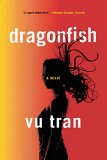Summary | Excerpt | Reviews | Beyond the Book | Read-Alikes | Genres & Themes | Author Bio

A Novel
by Vu TranThis article relates to Dragonfish
 In Dragonfish, Suzy writes about leaving Vietnam with her daughter, and arriving on an island before finally being resettled in the United States. She was one of many boat people, and this aspect of the story might well be modeled after Vu Tran's real-life experiences where he and most of his family were refugees at Pulau Bidong before passage to Oklahoma. It was only in Oklahoma that Tran met his father for the first time.
In Dragonfish, Suzy writes about leaving Vietnam with her daughter, and arriving on an island before finally being resettled in the United States. She was one of many boat people, and this aspect of the story might well be modeled after Vu Tran's real-life experiences where he and most of his family were refugees at Pulau Bidong before passage to Oklahoma. It was only in Oklahoma that Tran met his father for the first time.
Situated off the northeast coast of Malaysia, Pulau Bidong (pulau means island in Malay) was largely uninhabited until shortly after the fall of Saigon in April 1975 (see Beyond the Book for The Sympathizer) when the first refugees from Vietnam, a boatload of 47 people, made the hazardous 700 mile trip across the South China sea. Barely one square kilometer in area, the island, about a 40-minute boat ride from mainland Malaysia today, saw a steady influx of refugees whose numbers expanded substantially in 1978 when the island became an official refugee camp.
 With many Southeast Asian countries refusing to admit refugees spilling over into their borders, Bidong became a waystation for refugees seeking asylum elsewhere. Although stays were only supposed to be temporary, holding periods for more than a year became pretty common. By mid 1979, it was one of the most densely populated places with 40,000 people straining a camp designed for about 4,000.
With many Southeast Asian countries refusing to admit refugees spilling over into their borders, Bidong became a waystation for refugees seeking asylum elsewhere. Although stays were only supposed to be temporary, holding periods for more than a year became pretty common. By mid 1979, it was one of the most densely populated places with 40,000 people straining a camp designed for about 4,000.
The trip to Bidong was dangerous and pirates ruled the seas. The son of two island refugees recounts his parents' harrowing trip where his mother had to tuck her wedding ring in the waistband of her pants, a precious piece of jewelry that she would eventually trade to contribute to a makeshift baking business she and her husband set up to make do on the heavily congested island. Food and water supplies were extremely scarce and even if the UNHCR helped refugees, their sheer numbers meant disease was rampant.
 With the Geneva Convention in July 1979, the West increased quotas to accept Vietnamese refugees and many slowly found their way to the United States, Australia, Canada and France. Bidong was also a refugee station for citizens of other IndoChinese countries such as Cambodia and Laos who were escaping persecution. By the time the island was closed as a refugee camp in October 1991, close to 250,000 Vietnamese had passed its shores. Around 9,000 refugees who remained were repatriated to Vietnam.
With the Geneva Convention in July 1979, the West increased quotas to accept Vietnamese refugees and many slowly found their way to the United States, Australia, Canada and France. Bidong was also a refugee station for citizens of other IndoChinese countries such as Cambodia and Laos who were escaping persecution. By the time the island was closed as a refugee camp in October 1991, close to 250,000 Vietnamese had passed its shores. Around 9,000 refugees who remained were repatriated to Vietnam.
Pulau Bidong is now a tourist spot and a popular, if poignant, destination for the many Vietnamese who once made it home.
Pulau Bidong, courtesy of Flickr upload bot
35 Vietnamese refugees wait to be taken aboard the USS BLUE RIDGE, courtesy of DHN
Jetty at Pulau Bidong, courtesy of Flickr upload bot
Filed under Places, Cultures & Identities
![]() This "beyond the book article" relates to Dragonfish. It originally ran in August 2015 and has been updated for the
August 2016 paperback edition.
Go to magazine.
This "beyond the book article" relates to Dragonfish. It originally ran in August 2015 and has been updated for the
August 2016 paperback edition.
Go to magazine.
Your guide toexceptional books
BookBrowse seeks out and recommends the best in contemporary fiction and nonfiction—books that not only engage and entertain but also deepen our understanding of ourselves and the world around us.